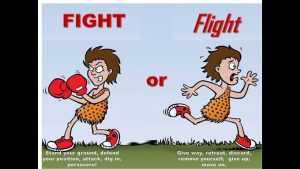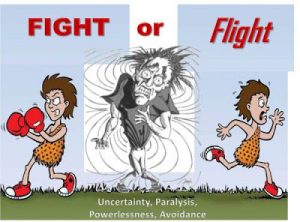Do you live in protection mode because of your pain?
Most of us have heard of the fight-or-flight stress response. It becomes activated when we believe there is a chance we can outfight or outrun real or perceived danger and stressful situations. It is a built in, survival mechanism that responds to a threat. Unfortunately, the body can also react in the same way to stressors that are not life-threatening, such as traffic jams, financial pressure, family difficulties, pain and other health conditions. In other words, anxiety, which is prevalent among all age groups, probably more so now than ever before.

When I was researching the topic of stress for my book, Diagnosis Dystonia: Navigating the Journey, I learned that stress experts have added the word “freeze” to the fight-or-flight stress response, with respect to the fact that instead of fighting or fleeing, we might sometimes freeze (like a deer in headlights) in painful or traumatic situations. This is very intriguing to me as it relates to dystonia and other chronic conditions, especially those that involve pain.
The freeze response differs from fight-or-flight in that it gets activated due to an inability to take action (like a mouse trapped in a corner by a cat). One feels helpless to fight or flee the threatening, painful, or stressful experience, so it freezes. The body becomes both tense and paralyzed at the same time. As illustrated in the photo below, uncertainty, powerlessness, and avoidance are characteristics used to describe the freeze response, the same words many of us use to describe how we often feel.

Think about the common symptoms of dystonia and pain which include contractions, stiffness, and rigidity. Out of fear of worsening our symptoms, many of us live in “protection mode” where we consciously restrict our movements, (to the best of our ability), to try and decrease pain and/or involuntary body movements. Some people also do this to try and hide their symptoms from others, which can be more exhausting than just letting their body do what it wants. Often, without knowing it, we also forget to breathe.

Purposely restricting our movements, avoiding activities and life events that may increase our symptoms, not breathing rhythmically, and holding ourselves in postures to try and prevent further pain and involuntary movements, is very similar to the freeze response, which adds more stress than already exists.

Since relaxation and healing are prevented when the freeze response is active, we must instead do activities that engage the parasympathetic nervous system, the part of the nervous system that conserves energy by slowing the heart rate and relaxes muscles. It also breaks the cycle of anger, fear, worry, and pain, making us more susceptible to healing.
These activities include relaxation and breathing exercises, TRE (Trauma Releasing Exercises), EFT (Emotional Freedom Technique), Tai Chi, Qi Gong, yoga, massage, acupuncture, counseling/therapy, aerobic exercise, dance, biofeedback, and many other therapies and practices. Doing whatever you can to engage the parasympathetic nervous system is so important because it is only when the body finds relaxation can it reverse the damaging effects of stress and anxiety. In other words, living in conscious protection mode can do more harm than good.
___________________________

Tom Seaman is a Certified Professional Life Coach in the area of health and wellness, and the author of 2 books: Diagnosis Dystonia: Navigating the Journey (2015) and Beyond Pain and Suffering: Adapting to Adversity and Life Challenges (2021. He is also a motivational speaker, chronic pain and dystonia awareness advocate, health blogger, volunteer for the Dystonia Medical Research Foundation (DMRF) as a support group leader, and is a member and writer for Chronic Illness Bloggers Network, The Mighty, Patient Worthy, and The Wellness Universe. To learn more about Tom, get a copy of his books (also on Amazon), or schedule a free life coaching consult, visit www.tomseamancoaching.com. Follow him on Twitter @Dystoniabook1 and Instagram.


























Hi Tom i have mild athetoid cerebral palsy and dsytonia and an occupational therapist for the last 27years.im at the stage of life with frail dementia parents and a my husband has mylofibros, but is well controlled. I cant get away from stress at the moment and dsytonia is generally all over but focal in my face and the neck. I work in environment that i absorb others unintentionally stress. The last ten years rised my pain, increasing OA practice in almost every joint. But being a determined person and generally positive attitude i still cant get away from pain and discomfort which tired me out. Now started Gaberpentine at a low does. I try to listen to relaxing music binaural whuxh helps i like the article because it make me believe i am in a freeze state, which is the reason why I have pain. Great articles as is yours books.
Wow Deborah. That is a lot to be going through!! If you are in the freeze state, I would check out that section in the Stress Chapter of my Dystonia book. There are techniques to free ourselves from the freeze response. Also please check out 2 books- The Way Out by Alan Gordon and The Pain Habit by Drew Coverdale. I think the information will be helpful.
Wishing you peace and all the best…
Tom
Hi Tom
Deep breathing works for me and I don’t mean to sound flip. But my thought after many years was ‘if it works for child birth pain it can certainly help with other pain!! There is so much stress with dystonia, but the worst for me was trying to hide it and the compensation made it worse. But I know I am not as severe as some and I feel for others with constant pain. But your book waz a life changer for me. You know that. So for others out there suffering look after your own body, be selfish if you have to but most of all benkind to you.
Wonderful words of wisdom, Vye. Thank you and thank you about my book!
Sometimes getting deep into the pain and tension helps to dissolve it. I would recommend the concepts and brain trying exercises in The Open Focus Brain by Dr Les Fehmi.
I couldn’t agree more. Most of us want to run from pain which only makes it worse. I believe that when we embrace suffering of any kind, we can transcend it.
Perfect timing as always. I’m in panic mode constantly and more so now since developing a problem with my upper lip. I can’t talk….unless I have something (today it’s cherry swizzler candy pieces) in my mouth! So, when a student walks in my office…I put an almond, or the candy, etc in my mouth. I think this is why I have had colds back to back (germs) because I go 5-10 yrs with no sickeness. I’m working on the platform exercises and pray this goes away!
Hi Kay – I am so glad this came at a good time. Are your mouth symptoms because of dystonia? It is interesting how putting something in your mouth can offset those symptoms. I find that when I have something in my mouth it relaxes my shoulders and neck. Have you ever considered a connection between TMJ and those mouth symptoms.
Hello. This message could not have come ata better time. Yes I do feel like I live in protection mode It never had a name but that is it. Protection mode.
Constantly protecting my Dystonia so that the symptoms stay at bay, anything to feel some relief.
Thank you
Kim W
Hi Kim. Thank you for your comments and I hope you are finding some relief. Living with this condition is so hard and any bit of relief is a breath of fresh air.
Hi Tom, I find your topics very helpful with my Distonia that i have suffering with now for Ten years..
I am very sorry for the years of suffering and that I am able to help in some way. Wishing you the best with more than less better days ahead!
Excellent article Tom! I am printing this and putting it on the wall at home and work. You just described my daily life. You help me through every writing you share with us. I appreciate, respect and admire you.
Hi Connie! Thanks very much! That means a great deal to me to have you say. Your kindness and friendship has always been a treasure to me.
Just what I needed to read right now!
Thank you Tom
Hi Beth. I am very happy with the timing of this for you. Sending my best!
Hello, my name is Michelle. I have early onset childhood Dystonia and luckily I’m dopa-responsive. However, I do have a lot of pain and suffer stiffness. I also have tones of anxiety that I fight. I do use medications and I have searched out meditation and exercise. It does help a lot. I really want to help our community become their best selves. I believe by doing so, it will help me in my own journey with Dystonia. Have you any ideas as to how I can further work to advocate for people like me?
Thank you for your time.
Michelle Heston
Hi Michelle. I think one of the many ways to help ourselves is to help others, so thank you for your desire to do so. A few advocating ideas are writing blogs and articles, making videos, doing a podcast, setting up tables at local health fairs to educate the public, starting a local support group where people can come together and share their struggles and ideas for coping, getting involved with some of the national organizations and their awareness and education efforts. These are just a few ideas that come to mind. I hope they are helpful and again, thank you.